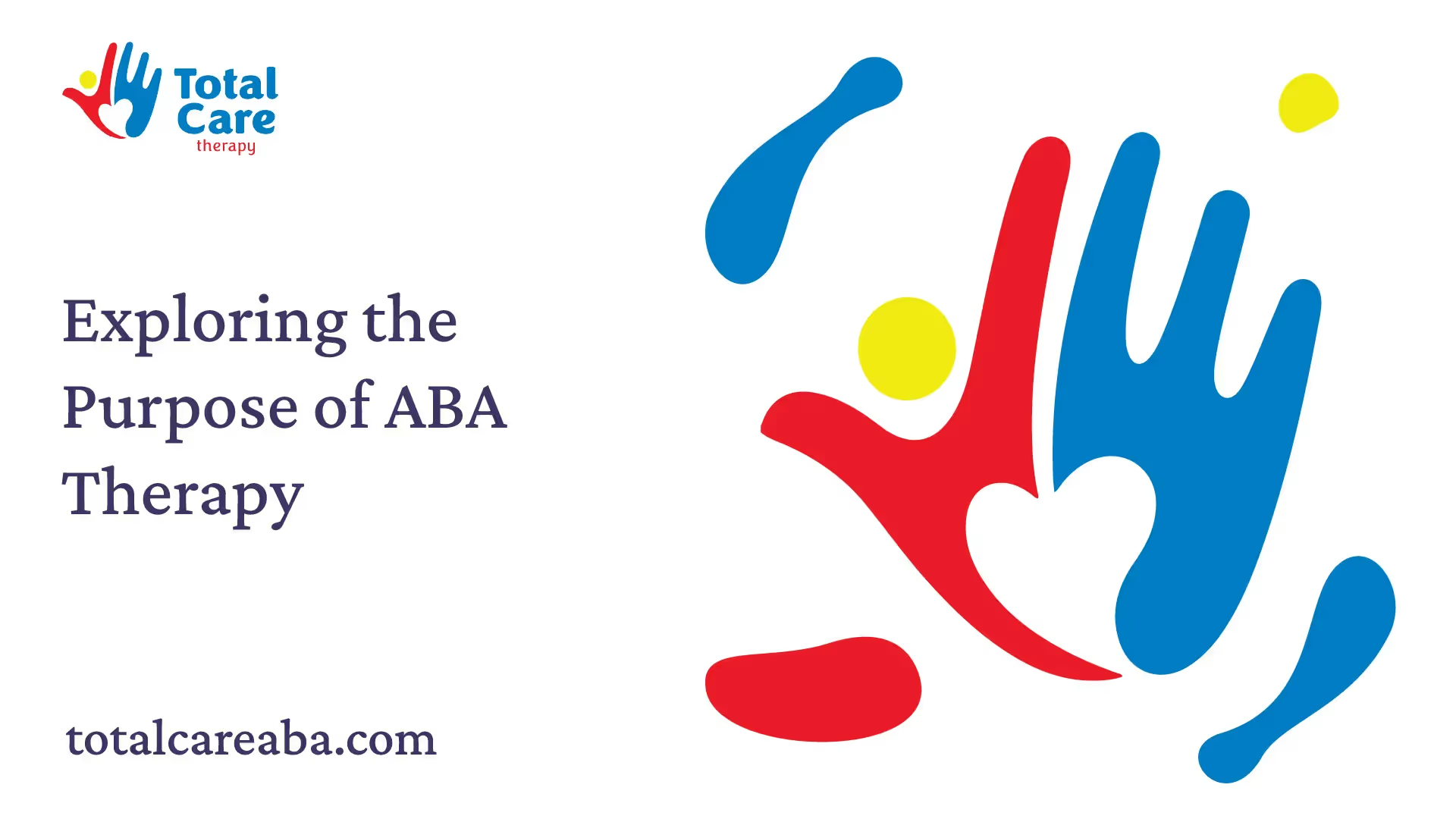Exploring the Purpose of ABA Therapy
Explore the purpose of ABA therapy for ASD, its techniques, benefits, and the significance of early intervention.
Exploring the Purpose of ABA Therapy
Understanding ABA Therapy
To help parents navigate the complexities of Autism Spectrum Disorder (ASD) and understand the therapeutic options available, it is crucial to delve into the specifics of Applied Behavior Analysis (ABA) therapy. This section will cover the basics of ABA therapy and its historical application in treating ASD.
Basics of ABA Therapy
Applied Behavior Analysis (ABA) is among the therapeutic approaches for Autism Spectrum Disorder (ASD). The primary purpose of ABA therapy is to utilize behavioral principles to bring about meaningful and positive changes in behavior. This therapeutic approach can be tailored according to the patient's objectives, making it a versatile tool in the treatment of ASD.
The strategy based on the ABA methodology is aimed at carrying out interventions during behavioral treatment. Skills are taught through the presentation of an instruction or a tip, with the child's help through a hierarchy of help. This approach allows children with ASD to independently perform most of the proposed tasks, especially those related to academic, social, and activities of daily living skills.

History of ABA in Treating ASD
ABA therapy has a long history of being applied in the treatment of ASD. Its usage in this context can be traced back to the work of psychologist Ivar Lovaas. He was the first to apply ABA therapy to individuals with ASD, paving the way for further research and refinement of the methodology [1].
In numerous studies, the outcomes from a therapeutic process using ABA to treat individuals diagnosed with ASD have been analyzed. Specific training data for each child's skills were presented, offering valuable insights into the effectiveness of this therapeutic approach.
As a result of this pioneering work and continued research, ABA therapy has become a widely accepted and utilized approach for treating ASD. With its ability to be tailored to each individual's needs and objectives, ABA therapy offers a promising avenue for improving the lives of those affected by ASD.
ABA Techniques and Principles
A variety of techniques and principles guide the implementation of ABA therapy, with each playing a critical role in shaping and guiding behavior. This section will delve into behavioral interventions, the Antecedent-Behavior-Consequence Model, and Discrete Trial Training (DTT).
Behavioral Interventions
Behavioral interventions are a cornerstone of ABA therapy. These interventions involve breaking down skills into small, manageable steps, teaching each step gradually, and measuring progress through data collection in each therapy session. The behavior analyst and therapists continuously assess progress and adjust teaching plans and goals as needed, involving family members and program staff in the process.
Key components of behavioral interventions include:
- Breaking down complex skills into smaller, achievable tasks
- Tailoring teaching strategies to the individual's needs
- Reinforcing positive behaviors to encourage repetition
- Monitoring progress and adjusting the program as necessary
These interventions are designed to promote skill acquisition and foster independence, ultimately improving the quality of life for individuals with ASD.
Antecedent-Behavior-Consequence Model
The Antecedent-Behavior-Consequence (ABC) Model is a fundamental principle in ABA therapy. It posits that behaviors are shaped or altered based on the antecedents and consequences that a person encounters. Environmental variables such as these are constantly at play, often impacting learning and behavior [3].
In this model:
- Antecedent refers to the event or environment that triggers a particular behavior.
- Behavior is the observed action performed by the individual in response to the antecedent.
- Consequence is the result or effect that follows the behavior.
Understanding the ABC Model allows therapists to identify the factors influencing behavior and develop appropriate interventions. A comprehensive ABA plan needs to address all these component areas: antecedent, behavior, and consequence.
Discrete Trial Training (DTT)
Discrete Trial Training (DTT) is a teaching strategy based in the principles of ABA that focuses on skill acquisition. It is particularly useful when teaching early learning skills such as receptive instructions or imitation, or when the learner needs skills broken down into small, learnable parts [3].
DTT involves:
- Breaking down complex skills into smaller steps
- Teaching each step individually until mastery
- Providing immediate feedback and reinforcement
- Repeating trials until the skill is learned and can be generalized
These techniques and principles collectively form the foundation of ABA therapy, playing a crucial role in helping individuals with ASD acquire necessary skills and improve their behavior. Their application can vary greatly based on the individual's needs, making customization and ongoing assessment key aspects of effective ABA therapy.
Benefits of ABA Therapy
ABA (Applied Behavior Analysis) therapy plays a vital role in managing Autism Spectrum Disorder (ASD). Its benefits span cognitive, social, and behavioral domains, significantly aiding the overall development of children with ASD.
Skill Improvement in Children with ASD
ABA therapy aids in enhancing various skills in children with ASD through its structured and individualized approach. A 2011 review of 27 studies across several peer-reviewed publications found that children who received ABA therapy experienced considerable improvements in cognitive abilities, language, adaptive behavior, and social skills Autism Specialty Group.
Positive Outcomes of ABA Therapy
ABA therapy garners positive outcomes for children with ASD by optimizing their potential and fostering their growth. A 2007 study indicates that children who receive ABA therapy early in their lives make more sustained gains in cognition, academics, adaptive behaviors, social behaviors, and language compared to children in control groups Autism Specialty Group. Furthermore, a 2012 study found that in 48 toddlers with autism, 6 months of ABA therapy starting around 2 years old improved both their ability to communicate with others and the severity of their autism symptoms.
Long-Term Effects of Early Intervention
Early intervention with ABA therapy is crucial in managing Autism Spectrum Disorder (ASD). It can help in developing skills, managing sensory experiences, and behaviors, leading to an improved quality of life both in the present and future. According to the Surgeon General’s autism treatment report, ABA therapy accounts for 45% of therapies that develop long-lasting and observable results for individuals with ASD Autism Specialty Group.
Studies have shown that early intervention for young children with autism, such as the Early Start Denver Model (ESDM) combining ABA and developmental psychology, can lead to positive outcomes. Children under two-and-a-half years old receiving 20 hours per week of therapy and parent training showed improvement in new skills, development, and communication. Some studies have indicated that early intervention can enhance a child's IQ by an average of 17 points Behavioral Innovations.
Early intervention for autism can help children develop coping skills, manage symptoms effectively, improve socialization, build better relationships with family and peers, and potentially lead to long-term benefits. Children who receive early intervention are more likely to attend regular education classes, have higher rates of employment in adulthood, and may require fewer support services later in life Behavioral Innovations.
Thus, the purpose of ABA therapy extends beyond immediate behavior management—it paves the way for children with ASD to lead a fulfilling and independent life.
Implementation of ABA Therapy
Upon understanding the purpose of ABA therapy, the next step is its implementation. This process involves the roles of behavior analysts, the creation of customized ABA programs, and the collection of data for monitoring progress.
Role of Behavior Analysts (BCBAs)
A board-certified behavior analyst (BCBA) typically provides ABA therapy services. They are responsible for designing individualized ABA programs. Therapists or registered behavior technicians (RBTs) work directly with individuals with autism under the BCBA's supervision to practice skills tailored to the individual's goals.
BCBAs have undergone extensive training and certification to understand and apply the principles of ABA effectively. They work closely with the individual with autism and their family, ensuring that the therapy addresses the individual's unique needs and supports their growth and development.
Customized ABA Programs
ABA programs are tailored to the needs of individual learners with autism, avoiding a one-size-fits-all approach. The goal of these programs is to promote independence and success in the short and long term by working on various skills necessary for the individual's development [2].
An ABA program might include teaching social skills, communication techniques, or self-care routines, depending on the individual's current abilities and future goals. The program's flexibility allows for adjustments as the individual progresses and their needs evolve.
Data Collection and Progress Monitoring
ABA therapy involves planning and ongoing assessment by a qualified behavior analyst (BCBA). Treatment goals are established based on the individual's skills, needs, and family situation. Progress is monitored through data collection and regular reviews with family members and program staff to make necessary adjustments.
Data collection is a critical aspect of ABA therapy. It allows the BCBA and the therapy team to track the individual's progress over time, providing a clear picture of what strategies are working and what areas need more focus. This data-driven approach ensures that the therapy remains effective and beneficial for the individual.
Implementing ABA therapy involves a collaborative effort between the individual with autism, their family, and a team of dedicated professionals. By tailoring the therapy to the individual's needs and regularly monitoring progress, ABA can significantly improve the lives of individuals with autism, helping them to achieve their full potential.
Effectiveness of ABA Therapy
When assessing the purpose of ABA therapy, it's important to evaluate its effectiveness. Evidence-based practice, impact on intellectual functioning, and social and behavioral improvements are a few areas of consideration.
Evidence-Based Practice
ABA therapy is recognized as an evidence-based best practice treatment for individuals with autism by esteemed institutions such as the US Surgeon General and the American Psychological Association. Over 20 studies have shown that intensive and long-term therapy using ABA principles improves outcomes for many children with autism. This results in gains in areas like intellectual functioning, language development, daily living skills, and social functioning.
The Surgeon General’s autism treatment report states that ABA therapy accounts for 45% of therapies that develop long-lasting and observable results for individuals with ASD [4].
Impact on Intellectual Functioning
ABA therapy can significantly impact the intellectual functioning of children with autism. A 2011 review of 27 studies found that children who received ABA therapy experienced improvements in cognitive abilities, language, adaptive behavior, and social skills [4].
Furthermore, a 2007 study indicates that children who receive ABA therapy early in life make more sustained gains in cognition, academics, adaptive behaviors, social behaviors, and language compared to children in control groups.
Social and Behavioral Improvements
ABA therapy also has a notable impact on the social and behavioral skills of children with autism. The therapy aims to increase helpful behaviors and decrease harmful or learning-impacting behaviors by applying the understanding of how behavior works in real situations.
A 2012 study found that in 48 toddlers with autism, 6 months of ABA therapy starting around 2 years old improved both their ability to communicate with others, as well as the severity of their autism symptoms [4].
With these findings, it's clear that ABA therapy plays a pivotal role in improving the lives of children with autism. It provides them with the skills and strategies needed to navigate life more effectively, emphasizing the purpose of ABA therapy.
Early Intervention with ABA
The purpose of ABA therapy extends beyond immediate behavior changes. It has a significant role in early intervention for children diagnosed with Autism Spectrum Disorder (ASD).
Significance of Early Detection
Early detection and diagnosis of ASD can pave the way for timely and effective intervention. With 1 in 36 children affected by autism, early diagnosis is key to initiating timely intervention, which can lead to an improved quality of life both in the present and future. The National Institute of Child Health and Human Development also emphasizes that early diagnosis and interventions for autism are more likely to have significant long-term positive effects on symptoms and later skills [6].
Tailored Therapy for Young Children
ABA therapy can be tailored for young children as early as two or three years old. At this age, the brain is rapidly developing, making it an ideal time for therapeutic services. Early intervention aims to address various areas including speech, communication, social skills, motor skills, self-care, and independence. These are crucial for the child's development and functioning later in life.
Long-Term Benefits of Early Intervention
Early intervention using ABA therapy has been associated with numerous long-term benefits. Studies have shown that early intervention models, such as the Early Start Denver Model (ESDM) combining ABA and developmental psychology, can lead to positive outcomes. Children under two-and-a-half years old receiving 20 hours per week of therapy and parent training showed improvement in new skills, development, and communication.
Some studies have indicated that early intervention can enhance a child's IQ by an average of 17 points.
Early intervention can also help children develop coping skills, manage symptoms effectively, improve socialization, and build better relationships with family and peers. Children who receive early intervention are more likely to attend regular education classes, have higher rates of employment in adulthood, and may require fewer support services later in life [5].
In conclusion, early intervention with ABA therapy is a pivotal step towards enhancing the lives of children with ASD, and understanding its importance can help parents make informed decisions for their children.
References
[1]: https://www.ncbi.nlm.nih.gov/pmc/articles/PMC10169625/
[2]: https://www.autismspeaks.org/applied-behavior-analysis
[3]: https://vcuautismcenter.org/resources/factsheets/printView.cfm/982
[4]: https://www.autismspecialtygroup.com/blog/benefits-of-aba-therapy-for-autism
[5]: https://behavioral-innovations.com/blog/critical-early-intervention-children-autism-spectrum-disorder/
[6]: https://www.nichd.nih.gov/health/topics/autism/conditioninfo/treatments/early-intervention








